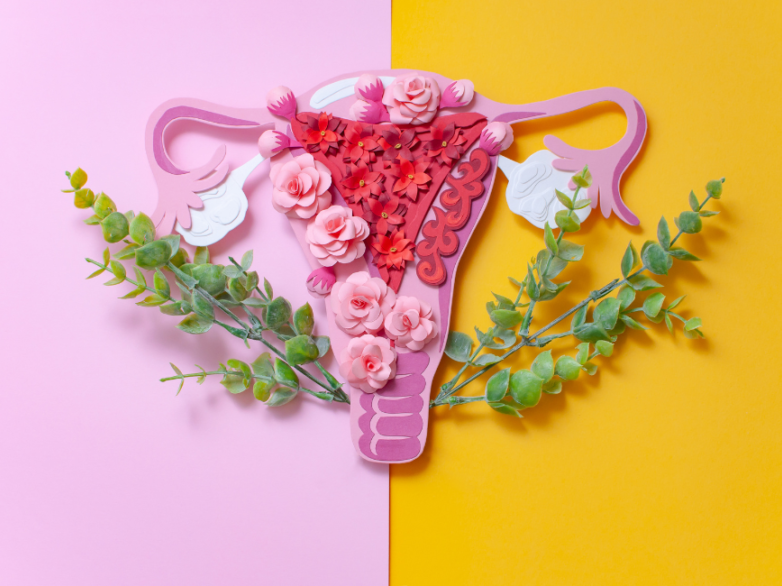
An Integrative Approach to Endometriosis
What Is Endometriosis?

Endometriosis is when the endometrial tissue escapes the uterus and attaches to to other areas, such as reproductive organs or the abdominal cavity. This causes pain as the tissue grows in response to fluctuations in hormones, such as estrogen, throughout the month.
Just as it is in the uterine lining, the tissue is extremely sensitive to hormonal changes and when estrogen levels go up, the tissue grows. This puts pressure on surrounding nerves and tissue, which can cause bleeding during your period, although the pain can be felt throughout the menstrual cycle and sometimes can be debilitating.
This is way more prevalent than we are led to believe. A lot of women have this and aren’t aware. Why is this? Period pain is strangely normalised. So, when people go to the doctors with bad period pain as a symptom, it can be pushed to the side and given medication to either help with the pain or given birth control to stop menstruation. The result of this is underlying health conditions, such as endometriosis manifesting and prolificating under the surface.
Symptoms of Endometriosis:
- Painful periods
- Painful urination
- Pelvic pain
- Painful intercourse
- Ovarian endometrial mass/tumour
- Infertility
- Constipation or loose stools
- Bowel pain
What Happens When You Have Endometriosis?

The reposition of the endometrial tissue on the outside of the uterus might deposit on the ligament that connects the uterus and the sacrum. When this happens, it creates back pain – and lots of it!
This can also deposit in the intestines. There are cases where endometrial tissue has even been deposited in joints and organs, such as the lungs and brain. How does this present itself? The pain manifests itself in those areas. Maybe you have knee pain when you’re menstruating? Perhaps severe pain around the head?
Endometrial tissue doesn’t deposit in the same way, it can be in the uterus, around the pelvis, ligaments, lots of places! It doesn’t matter where because hormones are circulating in the blood, so if we change hormonal levels, wherever the tissue is, it will respond.
When progesterone levels drop, the endometrial will shed wherever it is in the body. So, if it’s in the ovary, it would shed there, bleed, create irritation and, in turn, pain will be felt.
Overcoming Endometriosis
Firstly, you need to work out why you have endometriosis. The two contributing factors that I see so often is estrogen dominance and an immune system that is not functioning optimally.
There are different forms of estrogen that circulate, some forms are fine (and helpful), whilst others can be harmful when found in excess. Estrogen dominance means that there is too much estrogen circulating. Estrogen promotes growth, excess estrogen will promote the growth of the endometrial tissue that is in the wrong place.
So, whilst the endometrial tissue is proliferating due to estrogen, you need to work out why your immune system is not appropriately recognising the tissue and, consequently, destroying it.
One of the best ways to assess whether estrogen dominance is at the root of your condition, or if there are other factors at play, is to run an extensive hormonal panel. Lots of labs run these, but you do need to do it privately.

Unfortunately, conventional medicine would only look at certain types of estrogen, and just at a small snapshot in time. What you really want to know when you have endometriosis, is all the different types of hormones throughout the day. The Dutch test is great, it uses a combination of saliva and urine samples, which is 9 samples in total, and provides comprehensive information in various parameters. Such as, levels of estrogen and different types of estrogen, which is critical! This will also test LH, FSH, progesterone and even the levels of serotonin and cortisol. Serotonin and cortisol levels are useful for identifying whether there is a deficiency or excess. I generally use another comprehensive panel in practice but tend to recommend the Dutch test for clients with endometriosis.
When it comes to endometriosis, it is often necessary to address and correct these issues in order to get better. This may include addressing the root cause(s), such as chronic inflammation, an imbalanced microbiome, hormonal and metabolic imbalances, lack of physical activity, poor sleep and/or chronic stress.
The bottom line is that your immune system and, most likely, estrogen levels need attention and we need to find out WHY these systems are misfiring.
Functional Medicine Approach to Endometriosis
There are two main things that you need to focus on: detoxing and rebalancing. Your body needs help with detoxification. Estrogen and other hormone levels are consistently being thrown out of balance due to environmental toxins and endocrine disruptors in cosmetics and cleaning products. It has never been more important to detox the body and the best way to do this is to follow the 21 Day Reset Protocol and repeat a 7 Day Reset every 3-4 months.
For prevention after completing the 21 Day Reset, you want to aim to avoid as many excess or toxic estrogen sources as possible. Xenoestrogens, which are man-made chemicals, are huge contributors to estrogen dominance and you can get them from non-organic fresh produce, BPAs, environmental pollution, laundry detergents, cleaning products, cosmetics and air fresheners (and so much more!).
The second thing that is a non-negotiable to overcoming endometriosis is healing your gut. This is vital for eliminating your symptoms because 70% of your immune system is in your gut. Plus, if you have leaky gut, excess toxins will be leaking into your body and contributing to hormonal imbalance and toxicity overload. Follow a gut wellness protocol, such as the GI Protocol, to reset, rebalance and heal your gut. Until your microbiome is balanced, and your gut is functioning properly, you can’t fully get better!
Resources:
https://www.ncbi.nlm.nih.gov/pmc/articles/PMC7215544/

Follow Our Instagram For Exclusive Content





 د.إ / AED
د.إ / AED



Leave a comment